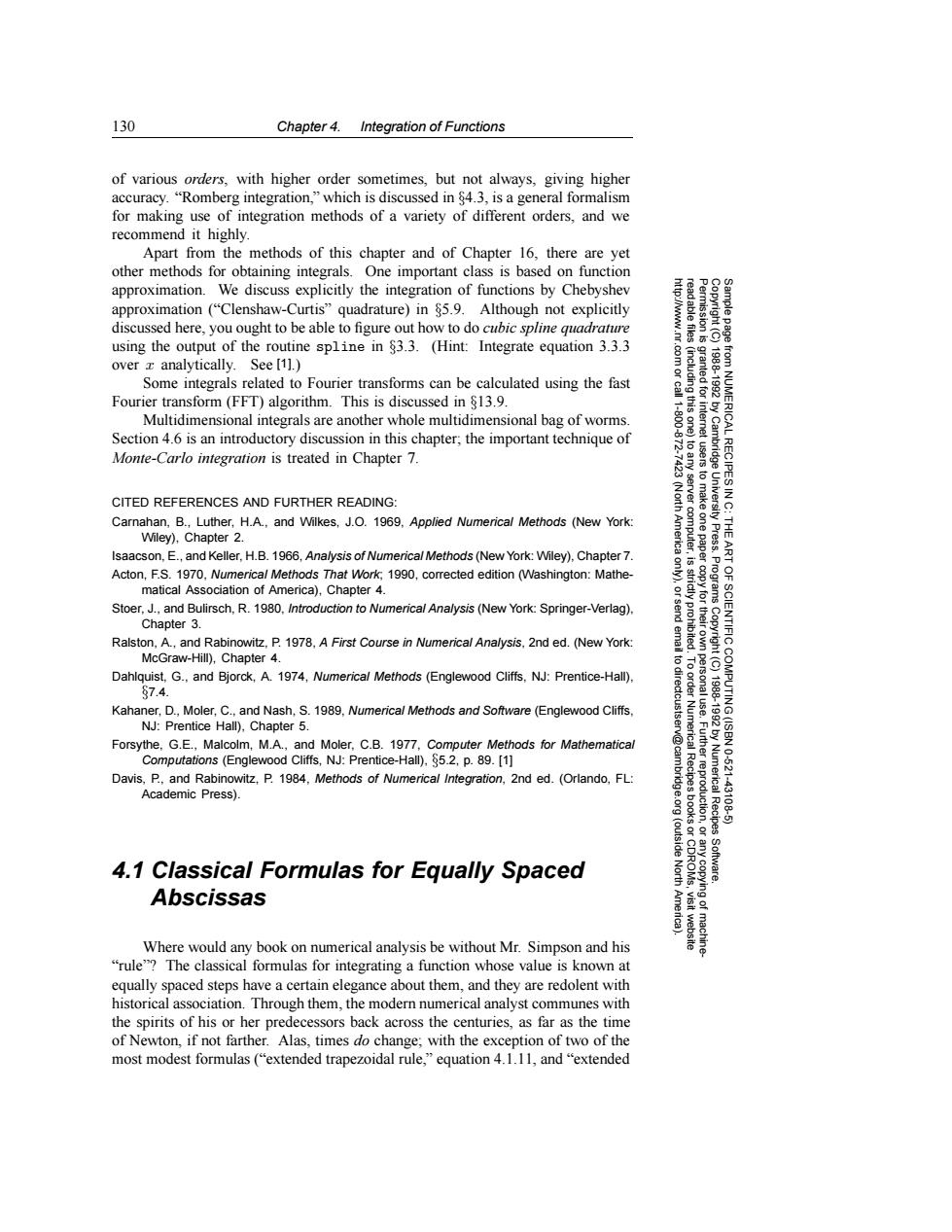正在加载图片...

130 Chapter 4.Integration of Functions of various orders,with higher order sometimes,but not always,giving higher accuracy."Romberg integration,"which is discussed in 84.3,is a general formalism for making use of integration methods of a variety of different orders,and we recommend it highly. Apart from the methods of this chapter and of Chapter 16,there are yet other methods for obtaining integrals.One important class is based on function approximation.We discuss explicitly the integration of functions by Chebyshev approximation(Clenshaw-Curtis"quadrature)in 85.9.Although not explicitly discussed here,you ought to be able to figure out how to do cubic spline quadrature using the output of the routine spline in $3.3.(Hint:Integrate equation 3.3.3 over z analytically.See [1].) Some integrals related to Fourier transforms can be calculated using the fast Fourier transform(FFT)algorithm.This is discussed in $13.9. Multidimensional integrals are another whole multidimensional bag of worms. 公 8 鱼君 Section 4.6 is an introductory discussion in this chapter;the important technique of Monte-Carlo integration is treated in Chapter 7. RECIPES CITED REFERENCES AND FURTHER READING: 9 Carnahan,B.,Luther,H.A,and Wilkes,J.O.1969,Applied Numerical Methods (New York: Wiley),Chapter 2. Isaacson,E.,and Keller,H.B.1966,Analysis of Numerica/Methods(New York:Wiley),Chapter 7. Acton,F.S.1970,Numerica/Methods That Work;1990,corrected edition (Washington:Mathe- matical Association of America),Chapter 4. Stoer,J.and Bulirsch,R.1980.Introduction to Numerical Analysis(New York:Springer-Verlag). S豆是日白 Chapter 3. Ralston,A.,and Rabinowitz,P.1978,A First Course in Numerical Analysis,2nd ed.(New York: McGraw-Hill),Chapter 4. 61 Dahlquist,G.,and Bjorck,A.1974,Numerica/Methods (Englewood Cliffs,NJ:Prentice-Hall), 97.4. Kahaner,D.,Moler,C.,and Nash,S.1989,Numerica/Methods and Software (Englewood Cliffs. NJ:Prentice Hall),Chapter 5. Forsythe.G.E.,Malcolm,M.A.,and Moler,C.B.1977,Computer Methods for Mathematical Computations (Englewood Cliffs,NJ:Prentice-Hall),85.2,p.89.[1] Davis,P.,and Rabinowitz,P.1984,Methods of Numerical Integration,2nd ed.(Orlando,FL: 心是 Academic Press). E喜 Numerical Recipes 10621 43106 (outside 4.1 Classical Formulas for Equally Spaced North Software. Abscissas Where would any book on numerical analysis be without Mr.Simpson and his "rule?The classical formulas for integrating a function whose value is known at equally spaced steps have a certain elegance about them,and they are redolent with historical association.Through them,the modern numerical analyst communes with the spirits of his or her predecessors back across the centuries,as far as the time of Newton,if not farther.Alas,times do change;with the exception of two of the most modest formulas("extended trapezoidal rule,"equation 4.1.11,and "extended130 Chapter 4. Integration of Functions Permission is granted for internet users to make one paper copy for their own personal use. Further reproduction, or any copyin Copyright (C) 1988-1992 by Cambridge University Press. Programs Copyright (C) 1988-1992 by Numerical Recipes Software. Sample page from NUMERICAL RECIPES IN C: THE ART OF SCIENTIFIC COMPUTING (ISBN 0-521-43108-5) g of machinereadable files (including this one) to any server computer, is strictly prohibited. To order Numerical Recipes books or CDROMs, visit website http://www.nr.com or call 1-800-872-7423 (North America only), or send email to directcustserv@cambridge.org (outside North America). of various orders, with higher order sometimes, but not always, giving higher accuracy. “Romberg integration,” which is discussed in §4.3, is a general formalism for making use of integration methods of a variety of different orders, and we recommend it highly. Apart from the methods of this chapter and of Chapter 16, there are yet other methods for obtaining integrals. One important class is based on function approximation. We discuss explicitly the integration of functions by Chebyshev approximation (“Clenshaw-Curtis” quadrature) in §5.9. Although not explicitly discussed here, you ought to be able to figure out how to do cubic spline quadrature using the output of the routine spline in §3.3. (Hint: Integrate equation 3.3.3 over x analytically. See [1].) Some integrals related to Fourier transforms can be calculated using the fast Fourier transform (FFT) algorithm. This is discussed in §13.9. Multidimensional integrals are another whole multidimensional bag of worms. Section 4.6 is an introductory discussion in this chapter; the important technique of Monte-Carlo integration is treated in Chapter 7. CITED REFERENCES AND FURTHER READING: Carnahan, B., Luther, H.A., and Wilkes, J.O. 1969, Applied Numerical Methods (New York: Wiley), Chapter 2. Isaacson, E., and Keller, H.B. 1966, Analysis of Numerical Methods (New York: Wiley), Chapter 7. Acton, F.S. 1970, Numerical Methods That Work; 1990, corrected edition (Washington: Mathematical Association of America), Chapter 4. Stoer, J., and Bulirsch, R. 1980, Introduction to Numerical Analysis (New York: Springer-Verlag), Chapter 3. Ralston, A., and Rabinowitz, P. 1978, A First Course in Numerical Analysis, 2nd ed. (New York: McGraw-Hill), Chapter 4. Dahlquist, G., and Bjorck, A. 1974, Numerical Methods (Englewood Cliffs, NJ: Prentice-Hall), §7.4. Kahaner, D., Moler, C., and Nash, S. 1989, Numerical Methods and Software (Englewood Cliffs, NJ: Prentice Hall), Chapter 5. Forsythe, G.E., Malcolm, M.A., and Moler, C.B. 1977, Computer Methods for Mathematical Computations (Englewood Cliffs, NJ: Prentice-Hall), §5.2, p. 89. [1] Davis, P., and Rabinowitz, P. 1984, Methods of Numerical Integration, 2nd ed. (Orlando, FL: Academic Press). 4.1 Classical Formulas for Equally Spaced Abscissas Where would any book on numerical analysis be without Mr. Simpson and his “rule”? The classical formulas for integrating a function whose value is known at equally spaced steps have a certain elegance about them, and they are redolent with historical association. Through them, the modern numerical analyst communes with the spirits of his or her predecessors back across the centuries, as far as the time of Newton, if not farther. Alas, times do change; with the exception of two of the most modest formulas (“extended trapezoidal rule,” equation 4.1.11, and “extended